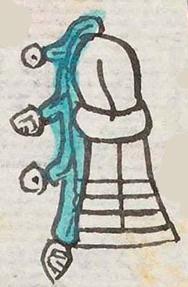Amaxtlan (Mdz13r)
This compound glyph for Amaxtlan consists of two visual elements, water (atl), cascading down the left side, and a white cotton loincloth (maxtlatl), with a bound loop at the top and horizontal lines at the bottom. The water has all the standard features, such as the turquoise color, the lines of current or flow, and the droplets/beads and turbinate shells splashing off the flow. The locative suffix -tlan is not shown here visually, but we do have the gloss confirming it is -tlan and not -tla (or -tlah, if we recognize the glottal stop).
Stephanie Wood
Loincloths were worn by men, in front of their genitals. A waist belt held them on. The maxtlatl here appears in white with black lines, something like the ones seen in the Codex Magliabechiano. More colorful loincloths appear in the Codex Ixtlilxochitl, for example, and they appear appear elsewhere in the Codex Mendoza, such as we show below and to the right. The differences in design probably related to social status (loincloths for the lower social strata were made from maguey fiber according to Henry B. Nicholson and Eloise Quiñones Keber in the Art of Aztec Mexico, 1983, p. 183), and perhaps also ethnicity and/or occupation. On some occasions, symbolic loincloths were carried in religious processions, such as those described by Kay Read, Time and Sacrifice in the Aztec Cosmos, 1998, p. 81, and Eloise Quiñones Keber in Representing Aztec Ritual, 2002, p. 124. Sometimes only a loincloth was worn (when the climate was warm), and at other times, the loincloths were accompanied by a tunic or a sleeveless cape.
Karttunen recognizes the maxtla- in the visuals, but suggests maxal- (something forked) for the intended morpheme. The resulting meaning is to refer to a forked river. If so, it is a reminder that we cannot take the meaning of all glyphs at face value.
Stephanie Wood
amaxtlan. puo
Amaxtlan, pueblo
Stephanie Wood
c. 1541, or by 1553 at the latest
Stephanie Wood
clothing, breechclouts, loincloths, taparrabos, water, shells, nombres de lugares

a(tl), water, https://nahuatl.wired-humanities.org/content/atl
maxtla(tl), loincloth, https://nahuatl.wired-humanities.org/content/maxtlatl
"River Fork [Place]" [Frances Karttunen, unpublished manuscript, used here with her permission.]
"Where There are Many Paper Loincloths" (Berdan and Anawalt, 1992, vol. 1, p. 171; but these authors suggest that water, rather than paper, may have been intended in this place name)
"Lugar de la Bifurcación del Río"
Stephanie Wood
Codex Mendoza, folio 13 recto, https://digital.bodleian.ox.ac.uk/objects/2fea788e-2aa2-4f08-b6d9-648c00..., image 36 of 188.
The Bodleian Libraries, University of Oxford, hold the original manuscript, the MS. Arch. Selden. A. 1. This image is published here under the UK Creative Commons, “Attribution-NonCommercial-ShareAlike 3.0 License” (CC-BY-NC-SA 3.0).



